752nd Tank Battalion in the Battle for Cecina
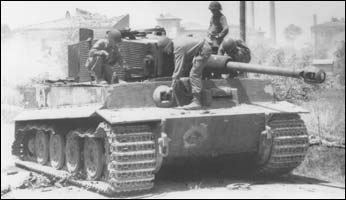 |
| GIs
of the 34th Infantry Division inspect Tiger 221 the day after it was
knocked out by B Company's 3rd Platoon. |
- Researched and Written by Robert Holt and Daniele Guglielmi -
The
battle for Cecina was a fiercely fought, rapidly shifting series of
attacks and counterattacks, beginning on 29 June 1944, and ending in
mopping up operations on 2 July. The heaviest fighting ended during the
evening of 1 July, when German infantry and armor launched a final
counterattack against the 133rd Infantry Regiment of the 34th Infantry
"Red Bull" Division.
Tanks from A Company of the 752nd were initially engaged in
Cecina on 30 June, the second day of the battle. The fighting was very
bitter, and at 1500 hours the 3rd Battalion was nearly cut off from the
rest of the 133rd Infantry Regiment in a very heavy counterattack. The
infantry suffered considerable casualties, and two of the A Company
tanks were knocked out by Panzerfausts and anti-tank grenades. The
remaining tanks and infantry were forced to withdraw, and A Company was
shifted to support the 135th Infantry Regiment on the eastern flank.
However, the tanks were unable to follow the infantry across the Cecina
River due to heavy weapons fire from the high ground to the east.
On 1 July 1944, B Company tanks were assigned to support the 133rd
Infantry Regiment's attack toward the eastern edge of the town of
Cecina. The tankers moved out at 0800 hours and reached their objective
by 1300, joining the infantry in the attack.
Meanwhile, the tankers
of A Company were really catching it even
further to the east. They had succeeded in crossing the Cecina River
and rejoining the 135th Infantry earlier in the morning. At 1400 hours,
they resumed the tank/infantry attack toward the critical road junction
of Highways 1 and 68. However, about 300 meters to the east of the road
junction, at the Sirigatti farm near the Acquerta Stream, the A Company
tankers ran into heavy fire from anti-tank weapons that were carefully
concealed at Villa Cartoni just north of Highway 68. Five of the
Shermans received direct hits and were set on fire, and four more were
immobilized. Miraculously, only three A Company tankers were wounded.
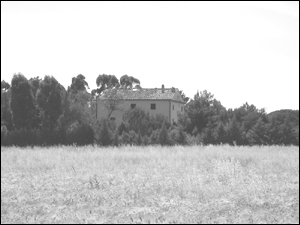 |
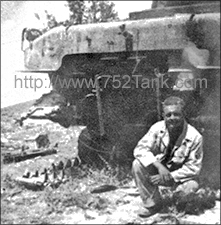 |
|
| The Villa Cartoni near the Acquerta Stream. German guns that were concealed here knocked out nine tanks of Company A in a matter of minutes on 1 July 1944. | One of the 752nd tanks knocked out near the Villa Cartoni. This one took a direct hit and burned. (Author's private collection) |
Back
in town, Company B of the 752nd was ordered to move all of its tanks
south of Cecina at around 1600 hours to support a different attack to
the western edge of town. The commander of Company E of the 133rd
Infantry Regiment heard his supporting tanks preparing to move out, and
quickly convinced Major Woodbury of the 752nd to leave one platoon of
tanks behind to defend the in-town forces. These were the five tanks
that comprised B Company's 3rd Platoon.
At 2030 hours, the five tanks from the 3rd Platoon of B
Company of the 752nd received word via radio that the Germans were
launching a combined tank/infantry counterattack from the eastern side
of Cecina. The various American accounts differ in their estimates of
the strength of the German counterattack, ranging between 5 and 10
Tiger tanks and between a platoon and 200 infantry. Real-time radio
transcripts of the 133rd Infantry Regiment indicate the
strength of the
counterattack to be 5 tanks and 100 men. German accounts indicate that
the counterattacking strength consisted of two Tiger tanks, one StuG
III, and less than 50 grenadiers from the I./SS-PGR 35 of the 16.
SS-Panzergrenadier-Division RFSS.
Twilight was approaching as the Germans attacked, but there
was still sufficient daylight left and visibility remained good. The
sun was just above the horizon, and the moon was nearly at full
transit, and three-fourths illuminated.
The German column was led by Tiger 221 of the 2nd Platoon of
the 2nd Company of the 504th Heavy Panzer Battalion, commanded by
platoon leader Leutnant Keitel. The grenadiers were following their
tanks in close ranks, in columns of two on either side of the road. The
counterattacking column halted briefly in the cover of the brick
factory that still exists today in the northern part of Cecina.
Resuming its counterattack, the column advanced down a road from the
vicinity of Villa Bianca, and turned left onto Via Marrucci. Moving
slowly past Via Trento and Via Trieste, Tiger 221 began to negotiate a
curve to the right onto Via Montanara, which was a gravel road that
formed the eastern border of the town.
 |
| Map of Cecina, showing the path of Tiger 221 and the location of Sherman #11 during the final encounter. The shading on the map shows the destruction created by air and artillery bombardment, with solid black signifying complete destruction and the shaded areas showing light to moderate damage. |
Meanwhile, the five Sherman tanks of B Company's 3rd Platoon went out to meet the German counterattack. The platoon leader was Lieutenant Edwin W. Cox, commander of Sherman 11, which was a mid-production 75mm M4A1 virtually identical to the one depicted below.
Lieutenant
Cox's plan was to advance toward the brick factory near the northern
part of town, where the German column had first been spotted. As the
133rd Infantry took cover in the buildings in town, Lieutenant Cox
strategically dispersed four of his five tanks into the streets of
Cecina, then took his own tank alone up Via Montanara in an attempt to
intercept the advancing German column. The German and American lead
tanks were about to come face to face with one another, but neither
crew was aware of this because the topography and buildings obstructed
their view.
Cox's Sherman had just passed Via Manzoni on its left. Just
moments before Tiger 221 rounded the curve onto Via Montanara, the crew
of Sherman 11 spotted a German infantry soldier in a ditch alongside
the road. Unknown to the American tankers, the German scout was acting
as a "spotter" for Tiger 221. As the infantry scout stood up to motion
the Tiger on, he was immediately hit by machine gun fire, clasping his
stomach as he fell.
As the German spotter fell, the Sherman tank crew saw the main
gun barrel of Tiger 221 emerge from behind a two-story house on the
left side of Via Montanara near the curve in the road. At that moment,
Tiger 221 rounded the curve onto Via Montanara and came face to face
with the Lieutenant Cox's Sherman, at a distance of 75 to 100 yards.
Both tanks fired simultaneously. The Tiger's 88mm shell struck
the ground close to the left side of Cox's Sherman. The concussion of
the Tiger's shot lifted the left side of the Sherman off the ground,
but no damage was inflicted. At the same instant, the Sherman fired a
75mm armor piercing (AP) round, hitting the lower front hull of the
Tiger. Crew members of the Sherman recalled seeing the shell merely
bounce off the Tiger's hull. The only damage inflicted upon Tiger 221
by this hit was a chip in the Zimmerit coating, which is clearly
visible in after-action photographs.
The two tanks momentarily lost sight of each other in the dust
that had been raised by the firing and movement of the tanks. Tiger
221's crew was further handicapped by the loss of their infantry
spotter. Lieutenant Cox ordered his driver, Sergeant Raymond Holt, to
back Sherman 11 into the dust, and then turn left through a small
garden and position the tank tightly against the wall of a two-story
home midway between Via Manzoni and Via Marrucci. In this position, the
front of the Sherman was facing Via Trieste, and the rear was facing
Via Montanara, where the Tiger remained. Lieutenant Cox then traversed
the turret to the rear of his tank, with the main gun at the 5 o'clock
position. Lieutenant Cox positioned his tank in that fashion to allow
for a more rapid escape in the event that the Tiger approached from
their rear and could not be successfully disabled. He had taken a
calculated risk that the Tiger 221 would continue along its original
path, and cross in front of their traversed main gun.
 |
| Sergeant
Ray Holt stands on top of his M4A1 in the Spring of 1944, prior to the
battle at Cecina. This particular tank was destroyed in the advance on
Rome on 4 June 1944. After its loss, Sgt. Holt advanced as driver of
the platoon leader's Sherman #11, whose tactical number denotes the
first tank of the third platoon. When Sherman #11 destroyed Tiger 221
in Cecina, it employed a reversed-turret stance similar to the one
depicted here. Three weeks after Cecina, Sergeant Holt was given
command of his own tank for the remainder of the Italian Campaign. (Author's
private collection) |
Sherman 11 maintained this position for several minutes, while the German armor (or perhaps U.S. artillery) shelled the surrounding buildings. When the shelling stopped, Tiger 221 slowly lumbered down Via Montanara, unaware of the position of Cox's Sherman. In recent interviews, Tiger 221's crew members say that they believed the Sherman was in some brush to their 11 o'clock position.
The time was 2045 hours. Tiger 221 slowly rumbled down Via Montanara, crossing the position of Sherman 11, which was hidden behind the building. With its crew unaware of Sherman 11's position, the Tiger moved perpendicular to the Sherman's rear and directly in front of its traversed main gun. As Tiger 221 slowly crossed before them, Lieutenant Cox calmly told his gunner "Hold on, hold on…" until the Tiger was squarely in front of them. Employing a tactic that exploited the Tiger's thinly armored sides, Lieutenant Cox then gave the order to unleash an armor piercing (AP) round through the Tiger's right rear sponson, into the fuel tank.
Crew members of Sherman 11 estimate that they were between 25 and 30 yards from Tiger 221 when they fired. The very close range is corroborated by infantry eyewitness reports, by the commendation for the Silver Star that was later presented to Lieutenant Cox, and by detailed maps and photographic evidence.
The 75mm AP round penetrated Tiger 221's hull and immediately ignited the fuel tank. Eyewitnesses from both the 133rd Infantry and the Sherman crew say that Tiger 221's engine compartment burst into flames when it was hit. Just a few seconds later, Sherman 11 fired another round into the Tiger's right track for good measure, severing it.
 |
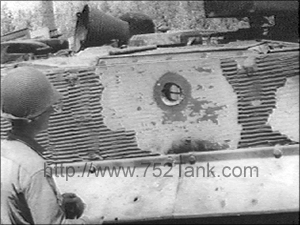 |
|
 |
 |
The
Sherman's gunner and loader both recall seeing some of Tiger 221's crew
escape from their disabled tank after the fuel tank was ignited.
Surprisingly, all of Tiger 221's crew survived, though four of them
were wounded, and two were in serious condition. The German crew
escaped in the midst of heavy machine gun and small arms fire into the
ditch on the side of Via Montanara, where they were rescued and
attended to by their own infantry.
After its crew escaped, Tiger 221 exploded when the spreading fire
ignited its full load of ammunition. The after-action photographs show
that the internal explosion was violent enough to buckle the hull roof
above the radio operator's position. The intense heat of the internal
fire brought the main gun into full recoil position. Based upon
interviews with a surviving crewmember of Tiger 221 as well as numerous
eyewitness accounts on the American side, Tiger 221 was not
self-destroyed by its crew after it was hit, despite previously
published speculation.
With Tiger 221 disabled and burning, the remaining Tiger tank
and StuG III withdrew. The counterattack rapidly collapsed with the
defeat of Tiger 221, and this remarkable tank versus tank action
effectively marked the end of the battle for Cecina. Some light
mopping-up operations continued the following day on 2 July.
Company A of the 752nd lost eleven of its fifteen tanks in Cecina. Despite the heavy loss of tanks, only six enlisted men and one officer were wounded, and two enlisted men captured. No 752nd tankers were lost in the heavy fighting in Cecina. Lieutenant Cox received a cluster to the Silver Star (his second award) for his "gallantry" and "courageous action" at Cecina. Six other men from the 752nd Tank Battalion also received commendations for their gallantry and heroic achievement in Cecina. This includes five Silver Star awards in addition to the one presented to Lieutenant Cox, and one Bronze Star Award.
Photos of Tiger 221
Whenever a Tiger tank was destroyed, it attracted a lot of curiosity seekers. Seldom did a GI get to see a Tiger up close, and to see one that was destroyed by Allied armor seemed to bolster his confidence. Though cameras were officially forbidden in combat zones, many GIs still carried them. Fortunately, quite a few GIs stopped to inspect Tiger 221, and have his photo taken beside it. The author has located photos of Tiger 221 among the personal collections of 752nd and 34th Infantry vets, and in the collections from other Allied passers-by from as far away as New Zealand and South Africa. In addition, several well-known and previously published photos and newly discovered film footage were sourced in the National Archives. Each of these visual impressions provided clues that were invaluable in reconstructing the story of Tiger 221. A sampling of photos follows:
 |
| Side view of Tiger 221. Note the charred turret, track damage, and missing Zimmerit coating. The Tiger crew believed Sherman 11 was hiding in the brush to its 11:00 position, thus explaining why the main gun is pointing away from the direction of the penetrating hit. The main gun is in full recoil position, not due to self-destruction as speculated elsewhere, but rather due to the intense internal fire and internal ammunitions explosions that severed the hydraulic lines. (Photo from the author's private collection) |
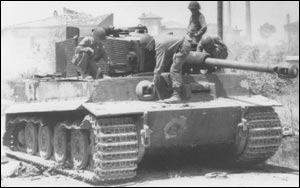 |
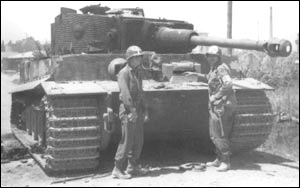 |
| Two very famous and well-published photos of Tiger 221, taken by the U.S. Signal Corps on 3 July 1944 while men of the 34th Infantry Division inspect the wreckage. While one photographer was taking these still photos, another photographer at the same location was recording the scene with a motion picture camera. (National Archives collection) |
 |
 |
| Two photos of Tiger 221 taken by 752nd tankers the day after the action. The photo on the left was taken by Sherman #11's driver, Sergeant Raymond Holt on the day after the action. It is believed to be one of the first photos taken of Tiger 221 after its destruction. The photo on the right was taken by another 752nd vet from B Company. It shows a very good view of the towing shackle cutout that was characteristic of late model Tiger tanks. (Both photos from the author's private collection) |
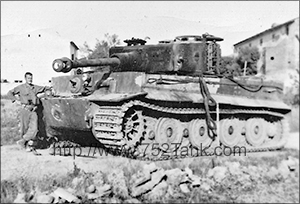 |
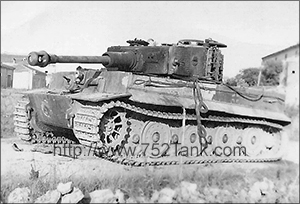 |
| Photos of Tiger 221 taken by a soldier from the 109th Engineer Combat Battalion shortly after the battle. The 109th ECB was attached to the 34th Infantry. These photos surfaced in 2007, and are the first to clearly show the left side of Tiger 221 before it was towed away. Note the Balkenkruz on the side, as well as the tow cables that were dislodged in the battle. (Both photos from private collection of L. Spindler) |
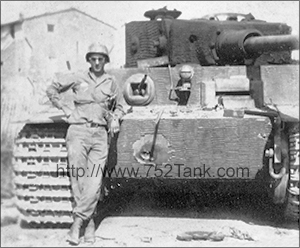 |
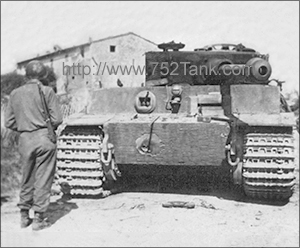 |
| Two photos of 752nd tankers inspecting Tiger 221 around noon on the day following its destruction. Note the .45 caliber tanker's "grease gun" that is slung over the tanker's shoulder. The house in the background was very badly damaged during the shelling, and was torn down after the war. These photos provide a good view of the first hit on Tiger 221's hull, which simply chipped the Zimmerit coating and scorched and dented the lower hull. (Both photos from the author's private collection) |
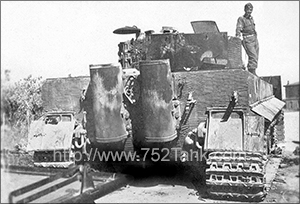 |
 |
| Two photos from a 34th Infantry officer who passed by the hulk of Tiger 221 a few days after it was destroyed. The photo on the left is the only known rear-view photo of Tiger 221. Note the missing jack, likely salvaged by a local farmer. The photo on the right shows a good view of the main gun in full recoil position. (Both photos from the author's private collection) |
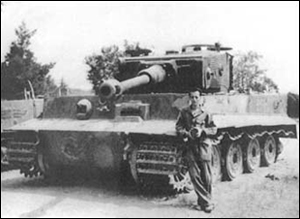 |
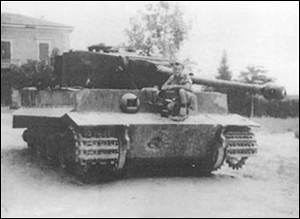 |
| Several days after Tiger 221 was destroyed, its lower track runs were removed and the tank was towed a few blocks away to a villa on Via Pola. The photo on the left was the first photo of Tiger 221's left side to surface, and remained the only photo of the elusive left side until new photos surfaced in 2007 (shown above). This is the only discernible marking on Tiger 221. The soldier posing on top of Tiger 221 in the photo on the right is from the South African logistics service. |
The above web article is excerpted and adapted from "The Battle For Cecina" by Robert Holt and Daniele Guglielmi, After the Battle Magazine, Number 114, Battle of Britain International, Ltd., London, 2001For an Italian language version of this story, see "I Combattimenti Per Cecina e la Destruzione del Tiger 221" by Daniele Guglielmi and Robert Holt, Storia & Battaglie No. 4, Vicchio (FI), Italy, Settembre 2000
Lt. Cox employed a tactic straight out of the textbook when he and his crew destroyed Tiger 221. Sherman tankers knew that the side sponson of a Tiger was relatively thin, and that if penetrated at close enough range, the gasoline tanks could be ignited. This information was originally published in the Soviet Artillery Journal, which the U.S. War Department interpreted and published on 16 December 1943 in an article entitled "Tactical and Technical Trends, Publication #40." This article was then distributed to Allied soldiers to help provide the knowledge and confidence to defeat the Tiger tank.
A quote from this article precisely indicates the tactic that was later employed by Lt. Cox and his crew:
"There are two armor plates on each side of the tank. The lower plate is partly covered by the wheels. This plate protects the engine and the gasoline tanks which are located in the rear of the hull, directly beyond and over the two rear wheels. Fire at the lower plates with armor-piercing shells from 76-, 57- and 45-mm guns. When the gasoline tanks are hit, the vehicle will be set on fire. Another method of starting a fire within the tank is to pierce the upper plates on the sides of the tank, thus reaching the ammunition compartments and causing an explosion."
The following diagram was excerpted from the U.S. War Department publication and modified to more clearly illustrate the approximate location of the penetration into Tiger 221's fuel tank (superimposed in red).
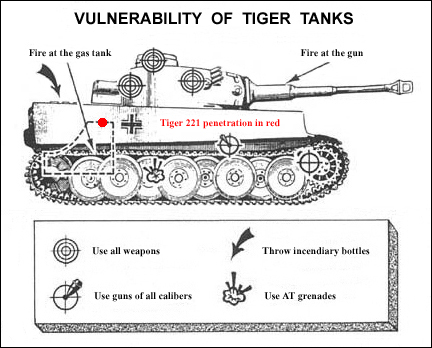 |
| Adapted
from "Tactical and Technical Trends, Publication #40" Original 1943 graphic sourced and republished by LoneSentry.com |
Historical
Narrative | Timeline
| Route Map | Units Supported
Campaigns | Cecina
| The Rock | Verona
Back
to Top of Page
Researched by Daniele Gugliemi & Robert J.
Holt
Web Version Written by Robert J. Holt
Page Content Copyright 2002 - 2025 Robert J. Holt
All Rights Reserved